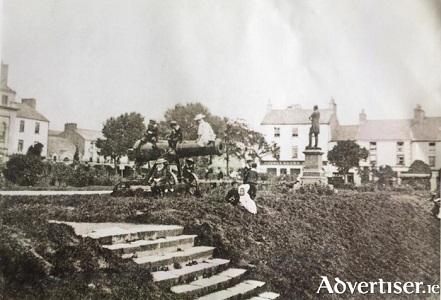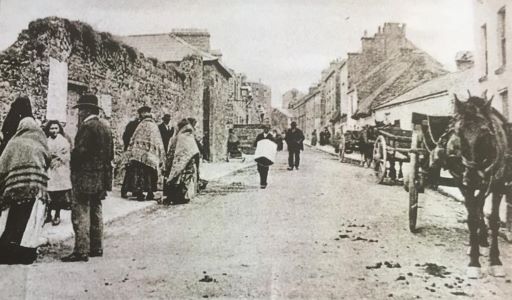Old Galway
THE LAST BOAT TO USE THE CANAL

by Tom Kenny
On March 8th, 1848, work was started on the Eglinton Canal. The Harbour Commissioners had been anxious to develop the New Dock. There were about 300 boats in the Claddagh and the amount of seaweed landed for manure in the spring of 1845 was 5,000 boat loads, averaging three tons each. The seaweed factory had been moved up to ‘The Iodine’, so the work on the canal was vital. It would allow boats to go from the Claddagh Basin up to the lake, boats from Cong and Maam to get to the sea and improve the mill-power on the Galway River.
THE CLADDAGH BASIN

by Tom Kenny
The actual cutting of what we now know as The Eglinton Canal began in March 1848. It provided much needed work during the Famine. It began at the Corrib Club and entered the sea near the Claddagh Church. The filling they dug out was used to fill terraces in UCG (which was also being built at the time) and to fill in the causeway behind Claddagh Quay. The Claddagh Basin and the Claddagh Quays were constructed especially to cater for the three hundred boats which were operating out of the Claddagh at the time.
The Guns in the Square

by Tom Kenny
The Galway Vindicator of July 25, 1857, reported the arrival in Galway on board the SS Lady Eglinton, of two cannon, which had been shipped from Woolwich Arsenal, the main storage and distribution depot of Crimean War ordnance. These cannon, described as “64-pounders of a heavy and clumsy description, each weighing two tons,” were taken from the docks to the goods yard beside the railway station, where they were made ready for the handing over ceremony. They were part of a significant amount of Russian ordnance which had been captured in 1854 by the 88th Regiment at the Battle of Inkerman during the Crimean War. They were two of a number of artillery pieces that were presented by the war department to various cities as trophies.
EYRE STREET AT THE TURN OF THE CENTURY

by Tom Kenny
Edward Eyre arrived in Galway with the Cromwellian army, became a major political figure and secured extensive grants from the Corporation and a considerable amount of property in both the city and county, mostly from displaced Catholic families, in the period 1660 – 1670. Most of this property was outside the town walls and included areas that we now know as the Railway station, Forthill Cemetery, Victoria Place, Merchant’s Road, the Commercial Dock, Woodquay, Suckeen and Eyre Square.
SALTHILL VILLAGE, 1920

by Tom Kenny
It is hard to believe that this is what the centre of Salthill village looked like exactly one hundred years ago. The house on the left belonged to a Mr. Kelleher who was a member of the R.I.C. It later became a guest house called the Rockville which eventually expanded into a small hotel and like many such premises in Salthill, it was fully licensed. It had high standards, the porter always wore a white coat and the waitresses wore proper uniforms. The distinguished writer Donal Mac Amhlaigh worked here for a while during the fifties.
A MEMORABLE DAY FOR GALWAY

by Tom Kenny
It was a joy to be a Galway person on the first Sunday of September 1980, the day our hurlers ended years of frustration, perennial underachievement, near misses, noble defeats, controversial defeats, the hard luck stories, the emptiness. There were so many highlights that day; the nervous expectancy as we drove to Dublin; the rumour that Fr. Iggy had been inspirational when saying Mass for the team that morning helped galvanise us all; the palpable nerves before the ball was thrown in; the early goals by P.J. Molloy and Bernie Forde; the terrific battle between Niall McInerney and Joe McKenna; the physicality of the entire match, the bravery of Michael Conneely; the emergence of Eamonn Cregan for Limerick in the second half; Joe McKenna scoring a goal for them with about ten minutes left; the Galway fingernails that were bitten away over the next ten minutes; the deflection of the sliotar over the bar from a last minute Limerick goal attempt; the final whistle, disbelief, a look at the scoreboard, Galway 2 – 15, Limerick 3 – 9, It’s true, we’ve won! The tears.
WALKING THE LINE

by Tom Kenny
‘Walking the Line’ is the title of an important book written by Kevin Brophy which describes his childhood growing up in Renmore Barracks. The ‘Line’ is the path alongside the railway line on the causeway between the barracks and the station, and is seen in our photograph c.1960.
WEST HOUSE, A BRIEF HISTORY

by Tom Kenny
West House was a large detached residence with extensive grounds in Helen Street. It had spacious rooms and belonged for a time to Admiral French.
It was bought by John Lushington Reilly, a customs collector who was a great benefactor of the town and the neighbourhood, especially during the great famine of 1822. Contemporary newspapers give accounts of the balls and receptions held in its rooms and grounds. The Connacht Journal of February 22nd 1827 refers to ‘an entertainment given to the 15th Regiment at West House’.
.png)